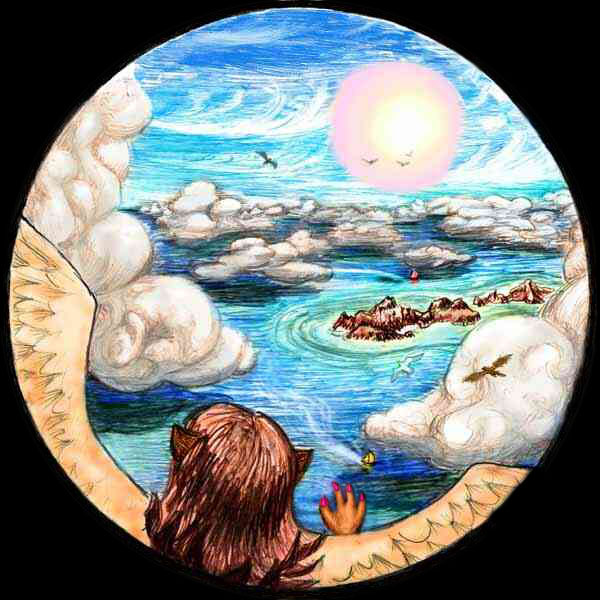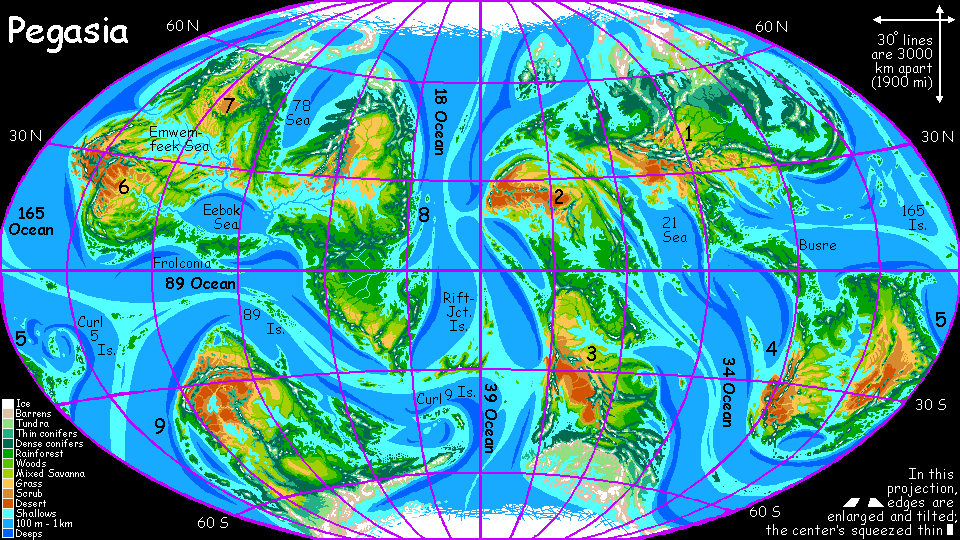World Dream Bank
home -
add a dream -
newest -
art gallery -
sampler -
dreams by
title,
subject,
author,
date,
places,
names
PEGASIA
Survival Tips
by Chris Wayan, 2006-9
Pegasia's homepage - Map - Geography & climate - Evolution - Critters - Gazetteer - Sketches - More worlds? Planetocopia!
Pegasia isn't Earth.
- 1: SUN
- Pegasia's smaller, cooler sun looks golden at noon, blushing lower in the sky to a pure spectral red Sol never achieves. Pegasian days have a warm tone, like perpetual afternoon, or gaslight, or firelight... Your eyes adjust quickly, so you'll see a full spectrum. You won't even be aware it's warmer--consciously. But it shifts your mood. It's subjectively pleasant, and you can't get sunburned, but there are subtler risks. Some tourists seem unconsciously to see it as artificial lighting, as if the place is a huge theme park; and they get reckless! Don't be seduced. The glare of an Earth desert or icefield may be harsher, but even in Pegasia's mellow light, dead tourists are dead tourists.
- 2: DAYS
- The sun hardly moves. Pegasia spins so slowly the day has 48 hours: over 25 hours of daylight, nearly 23 of night. (How can day and night be unequal? Pegasia's denser atmosphere bends light better than Earth's. So for a good 40 minutes at dawn and dusk, sunlight's refracted nearly five degrees around the planet's curve. Result? The sun seems to be shining above the horizon, when it's really just below it. Sound odd? It happens here, too--every day. The setting sun you see isn't there--it's several diameters below its image! A few minutes of extra light at dawn and dusk... But on Pegasia, it's over half an hour.) Long hot days (learn to siesta) and long nights (learn to like moonlight). Speaking of which...
- 3: THE NIGHT SHORTAGE
- In one hemisphere, Zeus hangs in the sky, a garish, striped, swirling "moon" 20 degrees across, 1500 times the area of our full moon, and over 4000 times brighter at night. You'll see full color at midnight--every night. Only the outer, Zeusless hemisphere ever gets dark at all. Oh--and every noon, Zeus swallows the sun in a two-hour eclipse! The gas giant becomes a huge red ring in the sky--a thousand refracted sunsets. Too spectacular to sleep through, the first time, but learn to siesta. You'll need the sleep.
- 4: WEATHER
- The long day causes strong temperature swings. Mini-seasons! Frost at dawn, shirtsleeve mornings, afternoon heatwaves broken by fierce thunderstorms (avoid getting struck by lightning--a leading cause of death here), autumnal evenings... The only constant will be change.
- 5: GRAVITY
- If you're from Earth, you weigh just five-eighths normal! You'll tend to skip and hop around, not walk; you can jog easily for miles. Feels good, increases your range greatly, but there are hidden risks--you'll also tend to slip and stumble, overestimating your traction; and you'll misjudge how fast objects fall. You'll be accident-prone for weeks.
- 6: OXYGEN
- You have nearly twice as much oxygen available. It's invigorating short-term--but you didn't evolve for it. Harsh on your lungs, if you over-exercise. It may age your tissues faster! Also: within days, in response, your blood will thin out--you'll feel fine, but by Earth standards you'll be anemic. So just before leaving, stay several days (a week if you can) in high mountains, and eat an iron-rich diet--or you may faint back in Earth air. So breathe easy, tour leisurely... and before settling on Pegasia, consult a doctor!
- and most important of all...

- 7: FLIGHT
- Pegasia's air pressure is 1.6 times sea level on Earth. Combine that with low gravity, and the dense air means lift under your wings. Yes, you can fly. On Earth today, no flying creature weighs over 15 kg (35 lbs), though some pterosaurs were quite a bit bigger. On Pegasia, low gravity and dense air make flight practical even for creatures as heavy as humans. So rent some strap-on wings! Be sure they're comfortable--take your time at the first fitting. You'll never impress the locals--you're too heavy for aerobatics, or carrying food home to your young, or soaring aerial courtship dances--but with a little practice and a good set of spidersilk wings, a human in reasonable shape CAN get off the ground and chug around. Cruising speeds are near 90 kph (55 mph)--as fast as a migrating goose.
And migrate you will. Because you're touring Pegasia under your own wingpower.
 TOUR PEGASIA! Survival tips first, then click on a region (just numbered for now): Continent 1 - 165 Is. - Continent 2 - Continent 3 - Rift-Junction and Curl 9 Is. - 1-4 Is. - Continent 4 - Continent 5 - Curl 5 Is. - Continent 6 - Continent 7 - Continent 8 - 89 Is. - Continent 9
TOUR PEGASIA! Survival tips first, then click on a region (just numbered for now): Continent 1 - 165 Is. - Continent 2 - Continent 3 - Rift-Junction and Curl 9 Is. - 1-4 Is. - Continent 4 - Continent 5 - Curl 5 Is. - Continent 6 - Continent 7 - Continent 8 - 89 Is. - Continent 9
The gazetteer will have a full index of native placenames, with descriptions--once the contests's over and we have natives to name them.
LISTS AND LINKS: Planetocopia - dreams of other worlds - ecology - climate change - evolution - populations and eco-crashes - natural disasters - terraforming - orbital dreams - sculptures and 3D art -
World Dream Bank homepage - Art gallery - New stuff - Introductory sampler, best dreams, best art - On dreamwork - Books
Indexes: Subject - Author - Date - Names - Places - Art media/styles
Titles: A - B - C - D - E - F - G - H - IJ - KL - M - NO - PQ - R - Sa-Sk - Sl-Sz - T - UV - WXYZ
Email: wdreamb@yahoo.com - Catalog of art, books, CDs - Behind the Curtain: FAQs, bio, site map - Kindred sites